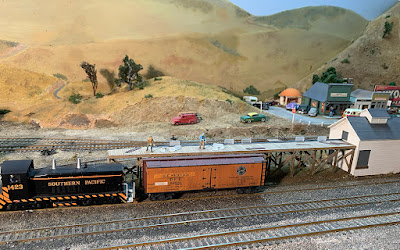As a regular columnist in Model Railroad Hobbyist (the “Getting Real” series of columns by several writers who take turns), my latest column is now appearing, the 27th I’ve written for this publication. It’s about “Modeling Perishable Shipping,” emphasizing the layout details that reflect handling of perishables, and also a little about operations. It’s in the “Running Extra” part of the April 2024 issue.
There are two main aspects I am trying to model (and that I described in the article). One, the loading of the cars (what can be seen outside the car), and two, ice refrigeration, both pre-icing (defined in the Protective Perishable Services tariff as filling the ice bunkers of an empty car before spotting for loading) and initial icing (again, tariff language for icing a loaded car before departure, at the nearest ice deck to the loading point).
For the loading part, we are limited in HO scale to what we can suggest from outside the car. On the loading docks of my packing houses, I often have a stack of shipping crates visible, as in the photo below at the Phelan & Taylor Produce Co. dock on my layout in East Shumala. The suggestion is that these crates are ready to load.
In addition, I spent a little space in the article describing the use of field boxes, in which harvest is brought to the packing house. A few of these are shown at right in the photo above. This is the easiest way we can depict the harvested perishables.
Icing, of course, is a familiar operating possibility on model railroading. Most of us cannot begin to model a prototype-size mainline icing station. These ice decks were often 80 to 100 cars long. If I recall, the largest model ice deck I’ve seen is at the La Mesa Club’s Tehachapi layout in San Diego, and it’s about 30 cars long. In HO scale, that is really big: 30 car lengths, at nominally 40 feet per car, is 1200 scale feet, or nearly 14 actual feet.
I have modeled a far smaller facility, typical of small towns, only a two-car deck, and located at a private ice company. Such companies usually did not have the capacity to freeze 300-pound ice blocks for reefer icing, and accordingly the reefer ice was shipped in. (That made it what PFE called an ITP, an Ice Transfer Plant.) Below I show an Ice Service reefer about to be spotted at the loading door in the ice building (at right). Note that its ice hatches have been blanked off; the ice bunkers have been removed for more loading space.
Meanwhile, on the deck, I’ve modeling the workmen using the two typical ice-handling tools. Below, the man at left holds a “bident,” a two-pronged fork used to chop the ice into smaller pieces, and the man at right holds a “pickaroon,” with a point for pushing ice blocks, and a hook for pulling them toward you. Note that the ice is not clear. Modelers who have clear ice on their ice decks need to sand it so it is at most translucent, which is how ice on real ice decks looked.
The photo above is from an earlier period, before I added the metal sliding tray that the workmen used to slide ice out along the deck, and also added some smaller ice chunks. In the photo below, you see open ice hatches, with the plugs on the underside of each hatch cover.
Lastly, I touched on the issue (mentioned above) of pre-icing and initial icing. A couple of the packing houses on my layout don’t have their own pre-cooling capability, and must receive pre-iced empties (all the other houses, since they do pre-cool their produce, receive un-iced empties).
This can be indicated in a waybill, as you see below, in the line just above the cargo description. The mention of Section 2 under “CPS” (Carrier Protective Service) means “standard refrigeration,” that is, ice in the bunkers.
My purpose in this particular MRH article was to emphasize how one can model perishable shipping, from harvest and loading, to icing, to long-range car movement. Hopefully I provided a few insights that might help modelers decide what they want to include, or can include, and how to model it.
Tony Thompson





No comments:
Post a Comment